The Legacy of Joseph Barnabas in Cyprus
Paul's mentor and missionary traveling companion
August 30th, 2011
Before we left PA, I bought a new battery for Lynne’s beloved MacBook. The original was not holding a charge very long, so we decided that a replacement was a good investment for the trip to Cyprus. It was also much cheaper than getting one from an Apple dealer. Unfortunately, her computer started to do annoying things—like just shutting down with no warning. Her frustration level was about to max out.
We found an Apple dealer close to CAARI, and we took the MacBook in for analysis. It turns out that the battery I bought in the States was not fully compatible with Lynne’s computer—contrary to what the advertisement said. The part that controls the heat sink did not work. So Lynne’s Mac would just shut down because of overheating. Batteries are expensive in Cyprus! But we made a good contact.
The friendly Apple store owner has a good friend who regularly goes to the Monastery of St. Barnabas near Famagusta as part of a team doing restorations. The Apple owner gave us the man’s name and telephone number, and said that his friend would probably be glad to let us go with him to the monastery.
Lynne was so pleased to have her MacBook fixed that she insisted that we celebrate and get ice-cream at the Three Cows shop nearby. While there, we began talking with a local English professor. He is Cypriot, but he spent ten years in the United States and is married to an American. When he discovered our need for a car, he said that his father works in a bank and does business with car dealerships. So he will ask his father for advice for us.
On Cyprus, life is all about connections with people. And because we are friendly and interested in others, we keep meeting helpful people who eagerly give us advice that will help me to accomplish my research.
Posted in Uncategorized | Comments Off on Barnabas at Apple—Cars at Three Cows
August 29th, 2011
Sunday morning we took a cab to an Orthodox church where the priest conducts much of the liturgy in English. Father Joseph, who hails from Texas, is a convert to Orthodoxy, spent six months on Mt. Athos, and has a Cypriot wife and four young children. His tiny congregation meets in a small chapel in the basement of a large, Orthodox Church.
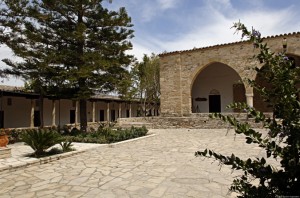 Fr. Joseph took us to see this monastery during Sunday afternoon. Given our Protestant backgrounds, we had to work hard at following the liturgy and trying to understand the symbolism of the priest’s movements, the burning of incense, etc. Most of the service involved chanting through a book, the Divine Liturgy of St. John Chrysostom (he lived AD 349–407). The book has Greek on the left page and an English translation on the facing page. Participants chanted most of the liturgy, including the readings from an Epistle and a Gospel. Those who get restless with long sermons will be interested to know that the homily was not more than five minutes. To see an online version of the liturgy, go to websites such as the following. http://www.ocf.org/OrthodoxPage/liturgy/liturgy.html
We were especially interested in the number of times that the liturgy praised the “glorious Lady Theotokos and ever-virgin Mary” and requested her prayers for Christians. We also noticed at one point that there was a brief prayer to Barnabas, as well as a short hymn to this saint.
Overall, it was a very good day of meeting welcoming Christians who were eager to be helpful with my research project on Barnabas.
Posted in Uncategorized | 3 Comments »
August 26th, 2011
Behind the Cathedral of St. John is the Makarios Cultural Center, Byzantine Museum. It contains an impressive collection of more than 100 icons—some quite large. The oldest icon dates to the seventh or eighth century. Most in the collection date from the twelfth through the nineteenth centuries. A number were rescued from destruction in Turkish occupied northern Cyprus.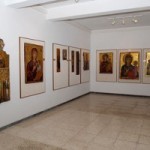
 I was not allowed to take any pictures, but here is a Mother of God icon similar to some in the Byzantine Museum. Eastern Orthodoxy highly reveres Mary, and many of the icons depict her holding the child Jesus. She is called Theotokos—the God-bearer or Mother of God. She is seen as the ideal saint, one who submitted completely to the will of God.
In the Byzantine Museum collection, icons depicting other saints, such as Peter, Mark and Luke, were somewhat common (Matthew less often). St. Nicholas and St. George (slaying the dragon) appear regularly. But, in this entire collection, there is only one icon of Barnabas. It is modest in size and placed beside a map of Cyprus, in a display showing the two men who brought Christianity to the island. To the left of the map is an icon of Paul, who holds a sword in his right hand and a book in his left. To the right of the map is Barnabas, seated on a throne and holding a book (probably his copy of Matthew’s Gospel) in his left hand.
I am intrigued. Why does Barnabas, the patron saint of Cyprus, get so little attention in the iconography of the island? I will try to determine why.
Posted in Uncategorized | 1 Comment »
August 26th, 2011
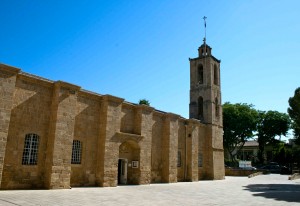 Today we walked to the Cathedral of Saint John, one of the most revered churches in Cyprus. Built in 1662, the church is actually quite small and is located in the courtyard of the much larger palace of the archbishop. I would not have guessed that such a plain exterior would enclose a wealth of Eastern Orthodox art. I was not allowed to take pictures, but the following link takes you to a photo of the artwork that covers the ceiling and walls. It is from a news story regarding Pope Benedict’s trip to Cyprus in 2010, and it also reveals the clothing worn by Orthodox priests. Scroll down to the last photo on the web page. Today we walked to the Cathedral of Saint John, one of the most revered churches in Cyprus. Built in 1662, the church is actually quite small and is located in the courtyard of the much larger palace of the archbishop. I would not have guessed that such a plain exterior would enclose a wealth of Eastern Orthodox art. I was not allowed to take pictures, but the following link takes you to a photo of the artwork that covers the ceiling and walls. It is from a news story regarding Pope Benedict’s trip to Cyprus in 2010, and it also reveals the clothing worn by Orthodox priests. Scroll down to the last photo on the web page.
http://cantate-domino.blogspot.com/2010/06/more-photos-of-pope-in-cyprus.html
In Orthodox belief, while standing in church, one is surrounded by saints from the past. The paintings reinforce the belief that you gather with the great crowd of God’s people including those from biblical times to the present. The images, which depict a wide variety of biblical events and later events as well, come down the walls and stop at the height of the people gathered in the church.
In the news photo, notice the depiction of Christ Pantokrator (the all powerful, ruler of all) on the ceiling directly above the head of the pope and the archbishop. From this position of primary importance radiate all the other paintings.
Also, note the iconostasis, the golden wall filled with icons behind the pope and the archbishop. The iconostasis, which does not go completely to the ceiling, separates the nave, where the people gather, from the sanctuary, where only the clergy go. Symbolically, the iconostasis provides a link between heaven (the holy of holies) and the nave (the holy place).
The icons are teaching devices. They remind Christians of Bible stories and reinforce Eastern Orthodox theology. Lynne and I will attend some Orthodox worship services during our time in Cyprus. Given the fact that our theological tradition differs so much from Greek Orthodoxy, it will be interesting to experience a gathering where the physical setting and the approach to worship represent an ancient tradition rich with symbolism.
Posted in Uncategorized | 1 Comment »
August 25th, 2011
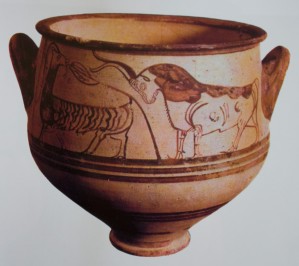 No cameras allowed in the museum, so I took this photo from the museum guidebook I purchased. This morning we walked to the archaeological museum in Nicosia. The building is not that impressive, but the collection of artifacts is stunning. Interestingly, the descriptions of the artifacts in the display cases were done with an old, manual typewriter–as in predating electric typewriters. I hope that the next time we go to the museum, we can go with an archaeologist so that we can ask all sorts of questions.
On our walk back to CAARI, we crossed paths with Daniel Hadjittofi, the director of the Fulbright Commission, and Keith Peterson, the new public affairs officer of the United States Embassy to Cyprus. Daniel asked if we would like to join them for lunch. I immediately said, “Yes.” We had a stimulating conversation about Cypriot politics over an extended lunch.
The Fulbright staff in Nicosia have been very friendly and accommodating. Ioli even tried to arrange for a portable AC unit to put in our blistering hot apartment. We don’t know if the CAARI administrators will allow it to happen. Dealing with heat seems to be a dreaded but accepted part of life here in the center. One woman goes around with a wet scarf around her neck. Another puts a wet towel on her forehead when she goes to bed. But we are grateful to be here conducting research on issues that we consider to be important.
Posted in Uncategorized | Comments Off on Lunch with an Embassy Officer
August 24th, 2011
In our first attempt at information gathering, we asked a Cypriot woman what she could tell us about Barnabas. She said “Not much—only what I learned about him in school.” She went on to say that he was not born in Cyprus but that he died here. He also contributed to the Cypriot church’s independence. His remains were buried near Famagusta, along with a Gospel. Because of Barnabas, the Cypriot archbishop was allowed to wear a special hat and ring and robe and was able to sign documents with a special ink. She also said that before 1974, she occasionally went to the Monastery of St. Barnabas near Famagusta, especially for events such as christenings. She has not been back to the monastery since the Turkish occupation began in 1974.
 She seemed to have no awareness of what the NT says about Barnabas. Her associations with the apostle stem largely from events in the fifth century. During that time, a patriarch of Antioch named Peter argued that Antioch, a church of apostolic origin, sent missionaries to establish the church in Cyprus. Cyprus should therefore be subject to Antioch. She seemed to have no awareness of what the NT says about Barnabas. Her associations with the apostle stem largely from events in the fifth century. During that time, a patriarch of Antioch named Peter argued that Antioch, a church of apostolic origin, sent missionaries to establish the church in Cyprus. Cyprus should therefore be subject to Antioch.
In 485, the bishops of Cyprus took their case to Emperor Zeno, armed with new evidence of their own apostolic origin. According to them, St. Barnabas had appeared in a vision to Anthemius, the bishop of Constantia, revealing the location of the apostle’s tomb. The following day, Anthemius followed the visionary directions and found the tomb, which contained the remains of Barnabas and also his personal copy of the Gospel of Matthew. It was these relics and the copy of Matthew that Anthemius took to Zeno. The emperor was so impressed that he issued an edict forbidding anyone from interfering with the autonomy (autocephaly) of the Cypriot churches. He also granted certain privileges to the archbishop of Cyprus: to sign documents with a special ink (cinnabar), to wear a purple robe instead of a black one, and to carry an imperial scepter instead of an episcopal staff.
My hunch is that many Cypriots will associate Barnabas primarily with their church’s independent status. We will find out soon.
Posted in Uncategorized | Comments Off on Cypriot beliefs about Barnabas
August 23rd, 2011
About 6:00 AM a construction worker started a large crane just below our new abode. Our tiny apartment has no AC, so we sleep with the windows wide open and a fan blowing air across our bed. The weather is hot, so getting started early makes sense. We must get into the rhythm and go to sleep earlier.
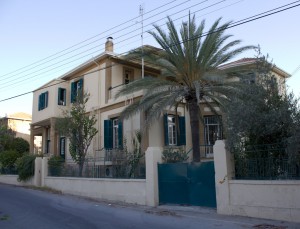 Our apartment is at the top right of the building. Residents at CAARI (Cyprus American Archaeological Research Institute) include a Cypriot doctoral student who conducts research on ancient ship wrecks (deeply tanned scuba diver and director of the CAARI library), a Polish doctoral student who studies amphorai (large pottery jars for hauling goods), and an American who is finishing her MA from a university in London and conducts research on mass graves (as in more modern ones) and their social and political implications. As a non-archaeologist, biblical scholar, I am a bit of an oddity here.
Today we met the folks at the Fulbright Commission and found them to be very helpful. Tomorrow, one of their administrators will take us to a bank to open an account, a car dealership to begin checking into the most economical means of having a car to use for four months while I conduct my research (do we rent or buy?), and an electronics store to get a cell phone. The director of the Cypriot Fulbright Commission will speak with some of the Cypriot bishops and arrange for me to meet with them. We will also try to meet with someone at the American embassy here in Nicosia to get advice from them. So, things are in progress.
Posted in Uncategorized | Comments Off on Nicosia alive at 6:00 AM
August 21st, 2011
Lynne and I arrived safely in Cyprus–jet lagged to be sure. We are just about unpacked in our tiny little apartment. The weather is hot, and we have no air conditioning; so we have some adjustments to make. An explosion near the main power generator for the island months ago took out the main power production part of Cyprus. So there are rolling brownouts. I am glad that I am using a laptop computer and can keep typing with our without the electricity being on.
Overall, the trip was uneventful–that is, if you leave out the fiasco of going needlessly through the security check at Philly (because of bad information given by a US Air employee regarding our checked baggage). By the time I got X-rayed and patted down and had my fingers swabbed for explosive residue, I was a bit edgy. Actually, I was angry. But I will just let that part go for now and write my senator about the situation later.
We have all sorts of things to learn about the banking system, the grocery stores, driving on the left side of the road, and in general learning the lay of the land. Some sleep and a good meal should help restore our sense of adventure.
Posted in Uncategorized | Comments Off on Safe Arrival in Cyprus
August 11th, 2011
Although Joseph Barnabas of Cyprus was arguably one of the five most influential leaders of the early Christian movement, his legacy is largely lost. Among biblical scholars, the contrast between minimal interest in Barnabas and fascination with his volatile former student, the Apostle Paul, is striking. An immense number of detailed books explore Paul’s life and teaching. Tragically, only one exists for Barnabas.
A Fulbright research grant will allow me to spend four months in Cyprus, homeland of Barnabas. From September through December 2011, I will locate and photograph texts, artifacts, inscriptions and artwork pertaining to Barnabas. I will also interview religious leaders (through interpreters when necessary), including members of monasteries, assembling an oral history of Barnabas and learning how modern Cypriots perceive his legacy.
Today considerable tension simmers over the division of the island following the turmoil that climaxed in the Turkish invasion in 1974. How might Barnabas’s legacy affect Orthodox thinking about how to deal with the tensions between Greeks and Turks on the island? Do they primarily remember him for his benevolence and compassion, as revealed in the New Testament? Or do Orthodox Cypriots remember him more for the stories about him in the fifth-century “Acts of Barnabas,” a document that helped them maintain their independence as a church? Is his legacy that of a peace-maker, or is he more a symbol of nationalism? And what are the practical implications? I will seek to find out.
Posted in Uncategorized | Comments Off on Recovering Joseph Barnabas, Patriarch of Cyprus
August 10th, 2011
I read an interesting book, The Mountain of Silence: A Search for Orthodox Spirituality, by Kyriocos Markides, a Cypriot who teaches sociology at the University of Maine. He obviously knows a lot of Cypriot leaders. So I wrote to ask his advice on places to visit and people to interview. He responded with a gracious message and told me several people to contact. I am extremely pleased with his helpfulness.
Posted in Uncategorized | Comments Off on Eastern Orthodoxy
|
|
 |
|
Monthly Archives:
Categorical Archives:
|









